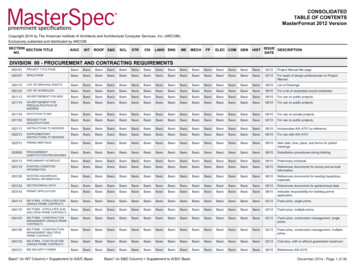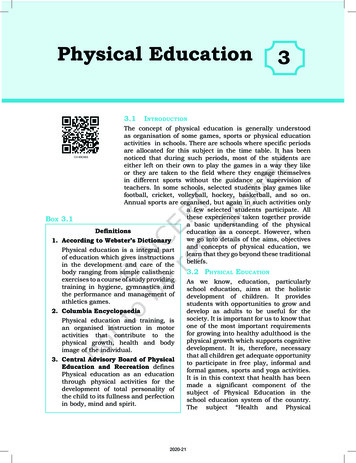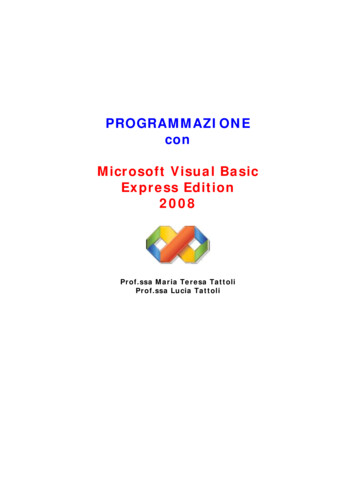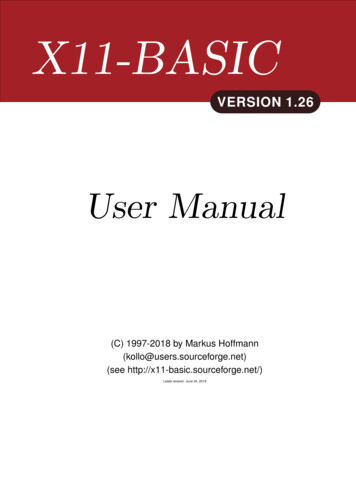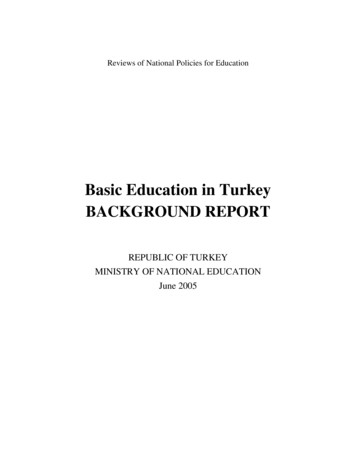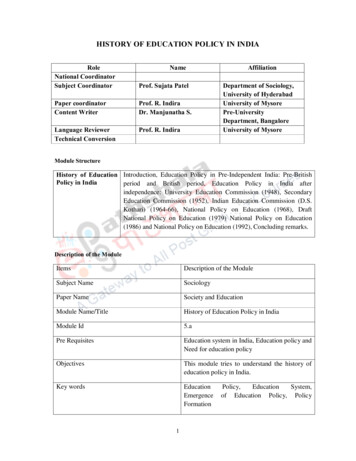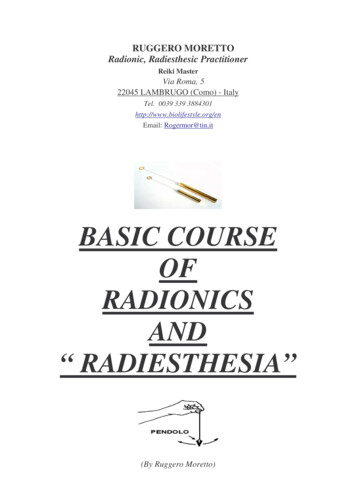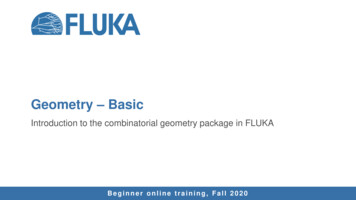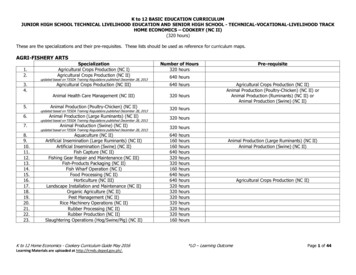
Transcription
K to 12 BASIC EDUCATION CURRICULUMJUNIOR HIGH SCHOOL TECHNICAL LIVELIHOOD EDUCATION AND SENIOR HIGH SCHOOL - TECHNICAL-VOCATIONAL-LIVELIHOOD TRACKHOME ECONOMICS – COOKERY (NC II)(320 hours)These are the specializations and their pre-requisites. These lists should be used as reference for curriculum maps.AGRI-FISHERY 9.20.21.22.23.SpecializationAgricultural Crops Production (NC I)Agricultural Crops Production (NC II)Number of Hours320 hoursAgricultural Crops Production (NC III)640 hoursAnimal Health Care Management (NC III)320 hoursAnimal Production (Poultry-Chicken) (NC II)320 hoursAnimal Production (Large Ruminants) (NC II)320 hoursAnimal Production (Swine) (NC II)320 hoursupdated based on TESDA Training Regulations published December 28, 2013updated based on TESDA Training Regulations published December 28, 2013updated based on TESDA Training Regulations published December 28, 2013updated based on TESDA Training Regulations published December 28, 2013Aquaculture (NC II)Artificial Insemination (Large Ruminants) (NC II)Artificial Insemination (Swine) (NC II)Fish Capture (NC II)Fishing Gear Repair and Maintenance (NC III)Fish-Products Packaging (NC II)Fish Wharf Operation (NC I)Food Processing (NC II)Horticulture (NC III)Landscape Installation and Maintenance (NC II)Organic Agriculture (NC II)Pest Management (NC II)Rice Machinery Operations (NC II)Rubber Processing (NC II)Rubber Production (NC II)Slaughtering Operations (Hog/Swine/Pig) (NC II)K to 12 Home Economics - Cookery Curriculum Guide May 2016Learning Materials are uploaded at http://lrmds.deped.gov.ph/.Pre-requisite640 urshourshourshourshourshourshoursAgricultural Crops Production (NC II)Animal Production (Poultry-Chicken) (NC II) orAnimal Production (Ruminants) (NC II) orAnimal Production (Swine) (NC II)Animal Production (Large Ruminants) (NC II)Animal Production (Swine) (NC II)*LO – Learning OutcomeAgricultural Crops Production (NC II)Page 1 of 44
K to 12 BASIC EDUCATION CURRICULUMJUNIOR HIGH SCHOOL TECHNICAL LIVELIHOOD EDUCATION AND SENIOR HIGH SCHOOL - TECHNICAL-VOCATIONAL-LIVELIHOOD TRACKHOME ECONOMICS – COOKERY (NC II)(320 hours)HOME ECONOMICSSpecializationNumber ofHours1.2.3.4.5.6.7.8.9.10.11.12.Attractions and Theme Parks Operations with Ecotourism (NC II)Barbering (NC II)Bartending (NC II)Beauty/Nail Care (NC II)Bread and Pastry Production (NC II)Caregiving (NC II)Commercial Cooking (NC III)Cookery (NC II)Dressmaking (NC II)Events Management Services (NC III)Fashion Design (Apparel) (NC III)Food and Beverage Services (NC .18.19.20.Front Office Services (NC II)Hairdressing (NC II)Hairdressing (NC III)Handicraft (Basketry, Macrame) (Non-NC)Handicraft (Fashion Accessories, Paper Craft) (Non-NC)Handicraft (Needlecraft) (Non-NC)Handicraft (Woodcraft, Leathercraft) (Non-NC)Housekeeping (NC II)16032064016016016016021.22.23.24.25.Local Guiding Services (NC II)Tailoring (NC II)Tourism Promotion Services (NC II)Travel Services (NC II)Wellness Massage (NC II)160320160160160updated based on TESDA Training Regulations published December 28, 2013updated based on TESDA Training Regulations published December 28, 2013K to 12 Home Economics - Cookery Curriculum Guide May 2016Learning Materials are uploaded at ry (NC II)Dressmaking (NC II) or Tailoring (NC II)160 ng (NC II)160 hourshourshourshourshourshours*LO – Learning OutcomePage 2 of 44
K to 12 BASIC EDUCATION CURRICULUMJUNIOR HIGH SCHOOL TECHNICAL LIVELIHOOD EDUCATION AND SENIOR HIGH SCHOOL - TECHNICAL-VOCATIONAL-LIVELIHOOD TRACKHOME ECONOMICS – COOKERY (NC II)(320 hours)INDUSTRIAL ARTS1.SpecializationNumber ofHoursAutomotive Servicing (NC I)640 hoursupdated based on TESDA Training Regulations published December 28, 20132.3.4.5.6.7.8.9.10.Automotive Servicing (NC II)Carpentry (NC II)Carpentry (NC III)Construction Painting (NC II)Domestic Refrigeration and Air-conditioning (DOMRAC) Servicing (NC II)Driving (NC II)Electrical Installation and Maintenance (NC II)Electric Power Distribution Line Construction (NC II)Electronic Products Assembly and Servicing (NC .19.20.21.22.Furniture Making (Finishing) (NC II)Instrumentation and Control Servicing (NC II)Gas Metal Arc Welding (GMAW) (NC II)Gas Tungsten Arc Welding (GTAW) (NC II)Machining (NC I)Machining (NC II)Masonry (NC II)Mechatronics Servicing (NC II)Motorcycle/Small Engine Servicing (NC II)Plumbing (NC I)Plumbing (NC II)Refrigeration and Air-Conditioning (Packaged Air-Conditioning Unit[PACU]/Commercial Refrigeration Equipment [CRE]) Servicing (NC III)Shielded Metal Arc Welding (NC I)Shielded Metal Arc Welding (NC II)Tile Setting (NC II)Transmission Line Installation and Maintenance (NC dated based on TESDA Training Regulations published December 28, 2013K to 12 Home Economics - Cookery Curriculum Guide May 2016Learning Materials are uploaded at rshourshourshoursPre-requisiteAutomotive Servicing (NC I)Carpentry (NC II)Electrical Installation and Maintenance (NC II)640 hourshours640 hours320320320640hourshourshourshoursElectronic Products Assembly and Servicing (EPAS) (NC II)Shielded Metal Arc Welding (SMAW) (NC II)Shielded Metal Arc Welding (GMAW) (NC II)Machining (NC I)Electronic Products Assembly and Servicing (EPAS) (NC II)Plumbing (NC I)Domestic Refrigeration and Air-conditioning (DOMRAC)Servicing (NC II)Shielded Metal Arc Welding (NC I)Electrical Installation and Maintenance (NC II)*LO – Learning OutcomePage 3 of 44
K to 12 BASIC EDUCATION CURRICULUMJUNIOR HIGH SCHOOL TECHNICAL LIVELIHOOD EDUCATION AND SENIOR HIGH SCHOOL - TECHNICAL-VOCATIONAL-LIVELIHOOD TRACKHOME ECONOMICS – COOKERY (NC II)(320 hours)INFORMATION, COMMUNICATIONS AND TECHNOLOGY ation (NC II)Broadband Installation (Fixed Wireless Systems) (NC II)Computer Programming (.Net Technology) (NC III)updated based on TESDA Training Regulations published December 28, 2013Number ofHours320 hours160 hours320 hoursComputer Programming (Oracle Database) (NC III)320 hoursComputer Systems Servicing (NC II)640 hoursupdated based on TESDA Training Regulations published December 28, 2013updated based on TESDA Training Regulations published December 28, 2007Contact Center Services (NC II)Illustration (NC II)Medical Transcription (NC II)Technical Drafting (NC II)Telecom OSP and Subscriber Line Installation(Copper Cable/POTS and DSL) (NC II)Telecom OSP Installation (Fiber Optic Cable) (NC II)K to 12 Home Economics - Cookery Curriculum Guide May 2016Learning Materials are uploaded at http://lrmds.deped.gov.ph/.Computer Systems Servicing (NC II)320 hoursComputer Programming (Java) (NC III)updated based on TESDA Training Regulations published December 28, 20 hoursComputer Systems Servicing (NC II)160 hoursComputer Systems Servicing (NC II)*LO – Learning OutcomePage 4 of 44
K to 12 BASIC EDUCATION CURRICULUMJUNIOR HIGH SCHOOL TECHNICAL LIVELIHOOD EDUCATION AND SENIOR HIGH SCHOOL - TECHNICAL-VOCATIONAL-LIVELIHOOD TRACKHOME ECONOMICS – COOKERY (NC II)(320 hours)Course Description:This curriculum guide is an exploratory course in Cookery, which leads to National Certificate Level II (NC II). It covers five common competencies that a highschool student ought to possess, namely: 1) knowledge of the use of tools, equipment, and paraphernalia; 2) maintenance of tools, equipment, and paraphernalia;3) performance of mensuration and calculation; 4) interpretation of technical drawings and plans; and 5) the practice of Occupational Health and Safety Procedures(OHSP) The preliminaries of this exploratory course include the following: 1) discussion on the relevance of the course; 2) explanation of key concepts relative tothe course, and 3) exploration of career opportunitiesCONTENTSTANDARDThe learnersdemonstrate anunderstanding of basicconcepts and theoriesin cookeryPERFORMANCESTANDARDThe learners independentlydemonstrate commoncompetencies in cookery asprescribed in the TESDATraining RegulationPERSONAL ENTREPRENEURIAL COMPETENCIES1. Assessment of Personal The learnersEntrepreneurialdemonstrate anCompetencies and Skills understanding one’s(PECs) vis-á-vis aPECspracticingentrepreneur/employee:1.1. Characterstics1.2. Lifestyle1.3. Skills1.4. Traits2. Analysis of PECs inrelation to anentrepreneurENVIRONMENT AND MARKET (EM)SWOT analysisThe learners1. Key concepts indemonstrate anenvironment andunderstandingmarket– PECsThe learners recognizehis/her PECs and preparean activity plan that alignsthat with that of apractitioner/entrepreneur incookeryCONTENTIntroduction1. Basic concepts incookery2. Relevance of the course3. Career opportunitiesK to 12 Home Economics - Cookery Curriculum Guide May 2016Learning Materials are uploaded at http://lrmds.deped.gov.ph/.The learners create abusiness idea based on theanalysis of environmentand market in cookeryLEARNINGCOMPETENCIESThe learners:1. explain basicconcepts in cookery2. discuss therelevance of thecourse3. exploreopportunities forcookery as a careerCODELO 1. Recognize PECsneeded in cookery1.1 assess one’s pecs:characteristics,lifestyle, skills, traits1.2 compare one’s pecswith those of anentrepreneurTLE PECS7/8-00-1LO 1. Generate abusiness idea thatrelates with a careerchoice in CookeryTLE EM7/8-00-1*LO – Learning OutcomeLEARNINGMATERIALS1. T.H.E IVHome Technology.Food Managementand Service II.Page 5 of 44
K to 12 BASIC EDUCATION CURRICULUMJUNIOR HIGH SCHOOL TECHNICAL LIVELIHOOD EDUCATION AND SENIOR HIGH SCHOOL - TECHNICAL-VOCATIONAL-LIVELIHOOD TRACKHOME ECONOMICS – COOKERY (NC II)(320 ESTANDARDSTANDARDCOMPETENCIESMATERIALS2. Differentiation ofenvironment and1.1 discuss swot1994. pp. 6-27.products, services,market in cookeryanalysiscustomers and their1.2 generate a businessbuying habitsidea based on the3. Competitors in theswot analysismarketUSE OF KITCHEN TOOLS, EQUIPMENT, AND PARAPHERNALIA (UT)1. Types of kitchen tools,The learnersThe learners independently LO 1. UtilizeTLE HECK7/8UT1. T.H.E IIIequipment anddemonstrate anuse and maintain tools,appropriate kitchen0a-1Home Technology.paraphernaliaunderstanding the use equipment, and materialstools, equipment,Food Management2. Uses of kitchen tools,and maintenance ofin cookery according toand paraphernaliaand Service I.equipment, andequipment in cookerystandard operating1.1 identify types of1991. pp. 42-46.paraphernaliaprocedurestools, equipment,and paraphernalia2. CBLM III1.2 classify the types ofFood Trades II.appropriate cleaningModule II.tools and equipmentLesson I.based on their uses1.3 describe the varioustypes of kitchentools, equipment,and paraphernaliaMAINTENANCE OF KITCHEN TOOLS, EQUIPMENT, AND PARAPHERNALIA (MT)1. Types of chemicals forLO 2. MaintainTLE HECK7/8MT1. T.H.E IIIcleaning and sanitizingappropriate kitchen0b-2Home Technology.kitchen tools andtools, equipment,Food Managementequipmentand paraphernaliaand Service I.2. Steps in cleaning and2.1 select various types1991. pp. 47-50.sanitizing kitchen toolsof chemicals forand equipmentcleaning and2. CBLM II3. Cleaning kitchensanitizing kitchenFood Trades.premises (floor andtools, equipment,Module I.storage areas)and paraphernaliaLesson I-II.2.2 clean and sanitizekitchen tools andK to 12 Home Economics - Cookery Curriculum Guide May 2016Learning Materials are uploaded at http://lrmds.deped.gov.ph/.*LO – Learning OutcomePage 6 of 44
K to 12 BASIC EDUCATION CURRICULUMJUNIOR HIGH SCHOOL TECHNICAL LIVELIHOOD EDUCATION AND SENIOR HIGH SCHOOL - TECHNICAL-VOCATIONAL-LIVELIHOOD TRACKHOME ECONOMICS – COOKERY (NC II)(320 ESTANDARDSTANDARDCOMPETENCIESMATERIALS4. Maintenance of kitchenequipment followingtools, equipment, andmanufacturer’swork areasinstructions2.3 use cleaning tools,equipment, andparaphernalia inaccordance tostandard operatingprocedures2.4 maintain kitchentools, equipment,and work areas1. Storing/stacking toolsLO 3. Store and stack TLE HECK7/8MT1. CBLM IIand equipmentkitchen tools and0c-3Food Trades.equipmentModule I.3.1 store or stackLesson I.cleaned equipmentand utensils safelyin the designatedplacePERFORM MENSURATION AND CALCULATIONS (PM)1. Types of measuringThe learnersThe learners independently LO 1. Carry outTLE HECK7/8PMtools and their usesdemonstrate anmeasure and calculatemeasurements and0d-42. Measuring techniquesunderstandingingredients in cookerycalculations in aof ingredientsperformingrequired task2.1. Dry ingredientsmensuration and1.1 give the2.2. Liquid ingredientscalculation in cookeryabbreviations and3. Measurementequivalents ofabbreviationsmeasurements4. Equivalent1.2 identify the types ofmeasurementsmeasuring tools5. Conversion of weights1.3 describe theand measurementsfunctions of6. Substitution ofmeasuring toolsingredientsK to 12 Home Economics - Cookery Curriculum Guide May 2016Learning Materials are uploaded at http://lrmds.deped.gov.ph/.*LO – Learning OutcomePage 7 of 44
K to 12 BASIC EDUCATION CURRICULUMJUNIOR HIGH SCHOOL TECHNICAL LIVELIHOOD EDUCATION AND SENIOR HIGH SCHOOL - TECHNICAL-VOCATIONAL-LIVELIHOOD TRACKHOME ECONOMICS – COOKERY (NC II)(320 ESTANDARDSTANDARDCOMPETENCIESMATERIALS1.4 measure ingredientsaccording to reciperequirement1.5 convert systems ofmeasurementaccording to reciperequirement1.6 perform substitutionof ingredients7. Costing the finishedLO 2. Calculate costTLE HECK7/8PMproducts/recipesof production0e-57.1. Expenses2.1 discuss principles of7.2. Mark-upcosting7.3. Selling price2.2 compute cost of7.4. Profitproduction2.3 validate computedcost of productionINTERPRET KITCHEN LAYOUT (KL)1. Alphabet of linesThe learnersThe learners independently LO 1. Read andTLE HECK7/8KL-0f- 1. T.H.E2. Architectural kitchendemonstrate aninterpret kitchen/shopinterpret kitchen6Home Technology.symbols, diagram, andunderstanding thelayouts based on givenplansFood Managementlayoutinterpretation ofblueprints1.1 read and interpretand Service I.diagrams, plans, andarchitectural kitchen1991. pp. 27-38.kitchen layoutssymbols and layoutaccording tospecifications in theblueprint1.2 determine parts andfunctions of akitchen layout3. Kitchen types andLO 2. Prepare aTLE HECK7/8KLlayoutskitchen layout0g-72.1 prepare a sketchand layout accordingthe type of kitchenK to 12 Home Economics - Cookery Curriculum Guide May 2016Learning Materials are uploaded at http://lrmds.deped.gov.ph/.*LO – Learning OutcomePage 8 of 44
K to 12 BASIC EDUCATION CURRICULUMJUNIOR HIGH SCHOOL TECHNICAL LIVELIHOOD EDUCATION AND SENIOR HIGH SCHOOL - TECHNICAL-VOCATIONAL-LIVELIHOOD TRACKHOME ECONOMICS – COOKERY (NC II)(320 ESTANDARDSTANDARDCOMPETENCIESMATERIALSPRACTICE OCCUPATIONAL HEALTH AND SAFETY PROCEDURES (OSHP)1. Concepts of theThe learnersThe learners independently LO 1. Importance ofTLE HECK7/8OHSP- 1. T.H.E IIIfollowing:demonstrate anpractice occupationalOccupational Health0h-8Home Technology1.1. Safetyunderstanding thehealth and safetyand SafetyCulinary Arts I1.2. Healthpractice ofProcedures1992. pp. 5-7.1.3. OHSP standardsoccupational health1.1 recognize the2. Safety Regulationsand safetyimportance of ohsp2. T.H.E III2.1. Clean Air Act1.2 explain safetyHome Technology.2.2. Building Coderegulations, hazardFood Management2.3. National Electricalcontrol practices,and Service I.and Fire Safetyand procedures1991. pp. 61-74.Codebased on2.4. Ph OSHSorganization3. CBLM IIproceduresFood Trades.Module II.Lesson I-II.3. Types of Hazard/Risk inLO 2. IdentifyTLE HECK7/8OHSPthe work placeHazards and Risks in 0i-93.1. Physicalthe Workplace3.2. Biological2.1 determine the types3.3. Chemicalof hazards and risks the3.4. Fireworkplace4. Control hazards andLO 3. Evaluate andTLE HECK7/8OHSP- 1. CBLM IIrisks in the workplaceControl Hazards and0j-10Food Trades.4.1. EnvironmentalRisks in theModule II.controlWorkplaceLesson II.4.2. Work practice3.1 Follow consistentlycontrolOHS procedure for4.3. Personal ProtectivecontrollingEquipment (PPE)hazards/risks5. Emergency-related drills3.2 Use Personaland trainingProtective6. Occupational HealthEquipment (PPE) inand Safety personalaccordance withrecordsOHSK to 12 Home Economics - Cookery Curriculum Guide May 2016Learning Materials are uploaded at http://lrmds.deped.gov.ph/.*LO – Learning OutcomePage 9 of 44
K to 12 BASIC EDUCATION CURRICULUMJUNIOR HIGH SCHOOL TECHNICAL LIVELIHOOD EDUCATION AND SENIOR HIGH SCHOOL - TECHNICAL-VOCATIONAL-LIVELIHOOD TRACKHOME ECONOMICS – COOKERY (NC II)(320 ESTANDARDSTANDARDCOMPETENCIESMATERIALS3.3 Conductemergency-relateddrills and training3.4 Maintain OHSPawarenessK to 12 Home Economics - Cookery Curriculum Guide May 2016Learning Materials are uploaded at http://lrmds.deped.gov.ph/.*LO – Learning OutcomePage 10 of 44
K to 12 BASIC EDUCATION CURRICULUMJUNIOR HIGH SCHOOL TECHNICAL LIVELIHOOD EDUCATION AND SENIOR HIGH SCHOOL - TECHNICAL-VOCATIONAL-LIVELIHOOD TRACKHOME ECONOMICS – COOKERY (NC II)(320 hours)Course Description:This curriculum guide on Cookery leads to National Certificate Level II (NCII). This course is designed for a high school student to develop knowledge, skills,and attitudes in the performance of Cookery tasks. It covers core competencies, namely: (1) cleaning and maintaining kitchen premises, (2) preparing appetizers,(3) preparing salads and dressings, (4) preparing sandwiches, (5) preparing desserts, and (6) packaging prepared foods.CONTENTIntroduction1. Core concepts incookery2. Relevance of thecourse3. Career opportunitiesCONTENTSTANDARDThe learnersdemonstrate anunderstanding of coreconcepts andunderlying theories incookery lessonsPERFORMANCESTANDARDThe learners independentlydemonstrate corecompetencies in cookery asprescribed in the TESDATraining SThe learners:1. explain coreconcepts in cookery2. discuss therelevance of thecourse3. exploreopportunities for acareer in cookeryCONCEPT REVIEWPERSONAL ENTREPRENEURIAL COMPETENCIES – PECs1. Dimensions ofPersonalEntrepreneurialCompetencies (PECs)1.1. three clusters ofPECS(achievement,planning, andpower clusters)1.2. characteristics2. Assessment of PECsThe learnersdemonstrate anunderstanding thedimensions andcharacteristics of PECsK to 12 Home Economics - Cookery Curriculum Guide May 2016Learning Materials are uploaded at http://lrmds.deped.gov.ph/.The learners recommendspecific strategies toimprove “weak” areas andsustain “strong” areas intheir PECsLO 1. Assess PersonalEntrepreneurialCompetencies1.1. explaindimensions/clustersof PECs and thedifferentcharacteristic traitsper cluster1.2. evaluate one’s PECs*LO – Learning OutcomeTLE PECS9-1200-1Page 11 of 44
K to 12 BASIC EDUCATION CURRICULUMJUNIOR HIGH SCHOOL TECHNICAL LIVELIHOOD EDUCATION AND SENIOR HIGH SCHOOL - TECHNICAL-VOCATIONAL-LIVELIHOOD TRACKHOME ECONOMICS – COOKERY (NC II)(320 ESTANDARDSTANDARDCOMPETENCIESMATERIALSBUSINESS ENVIRONMENT AND MARKET (EM)1. Factors in the business The learnersThe learners analyze howLO 2. Understand theTLE EM9-12-00environmentdemonstrate anfactor influence thebusiness environment 12. Identifying businessunderstanding thebusiness environment.and business ideasopportunitiesdifferent factors that2.1 explain howinfluence the businessThe learners relatedifferent factorsenvironment.experience in generatinginfluence thebusiness ideas orbusinessidentifying businessenvironmentopportunities.2.2 explain proceduresfor generatingbusiness ideas oridentifying businessopportunities2.3 generate businessideas and identifybusinessopportunitiesCLEAN AND MAINTAIN KITCHEN TOOLS, EQUIPMENT, AND PREMISES (KP)1. Kitchen tools andThe learnersThe learners independentlyequipment to bedemonstrate anmaintain clean kitchencleaned, sanitized, and understanding thetools, equipment, andstoredknowledge, skills, andpremises.1.1. cutting tools andattitudes required inequipmentmaintaining kitchen1.2. measuring toolstools, equipment, andand equipmentwork premises.1.3. mixing tools andequipment1.4. top-of-the-rangeequipment1.5. baking tools andequipmentK to 12 Home Economics - Cookery Curriculum Guide May 2016Learning Materials are uploaded at http://lrmds.deped.gov.ph/.LO 1. Clean, sanitize,and store kitchentools and equipment1.1 recognize kitchentools and equipmentto be cleaned andsanitized1.2 identify thechemicals to beutilized in cleaningand sanitizingkitchen tools andequipment1.3 prepare cleaningagents in*LO – Learning OutcomeTLE HECK912KP-Ia-11. CBLM IIFood Trades.Module I.Lesson I.Page 12 of 44
K to 12 BASIC EDUCATION CURRICULUMJUNIOR HIGH SCHOOL TECHNICAL LIVELIHOOD EDUCATION AND SENIOR HIGH SCHOOL - TECHNICAL-VOCATIONAL-LIVELIHOOD TRACKHOME ECONOMICS – COOKERY (NC II)(320 ESTANDARDSTANDARDCOMPETENCIESMATERIALS2. Types of chemicalsaccordance withused in cleaning andmanufacturer’ssanitizing kitchen toolsinstructionsand equipment1.4 clean and sanitize3. Methods of cleaningkitchen tools inand sanitizing kitchenaccordance withtools and equipmentprescribed standards4. Proper dishwashing1.5 store cleanedtechniqueskitchen tools and5. Techniques in storingequipment safely incleaned kitchen toolsthe designatedand equipmentspace6. Surfaces to be cleaned6.1. walls6.2. floors6.3. shelves6.4. benches and worksurfaces6.5. cookingequipment andappliances6.6. cold storageequipment6.7. storerooms andcupboards7. Types and uses ofcleaning agents7.1. specifications7.2. usage instructions7.3. methods ofmixing7.4. precautionarymeasures8. Sanitation proceduresK to 12 Home Economics - Cookery Curriculum Guide May 2016Learning Materials are uploaded at http://lrmds.deped.gov.ph/.LO 2. Clean andsanitize kitchenpremises2.1 recognize kitchenpremises to becleaned andsanitized2.2 classify and describethe uses of cleaningagents2.3 clean the kitchenarea hygienically inaccordance withfood safety andoccupational healthregulations2.4 clean surfaceswithout damagingproperty andadversely affectinghealth*LO – Learning OutcomeTLE HECK912KP-Ib-21. CBLM IIFood Trades.Module I.Lesson II.Page 13 of 44
K to 12 BASIC EDUCATION CURRICULUMJUNIOR HIGH SCHOOL TECHNICAL LIVELIHOOD EDUCATION AND SENIOR HIGH SCHOOL - TECHNICAL-VOCATIONAL-LIVELIHOOD TRACKHOME ECONOMICS – COOKERY (NC II)(320 ESTANDARDSTANDARDCOMPETENCIESMATERIALS9. Cleaning schedules2.5 use cleaning agentsin sanitizing kitchenpremises safely2.6 follow cleaningschedule based onenterpriseprocedures2.7 follow safety andfirst aid proceduresPREPARE APPETIZERS (PA)1. Identification of toolsThe learnersand equipment needed demonstrate an2. Tools, equipment, and understanding theutensils needed inknowledge, skills, andpreparing appetizersattitudes required in3. Cleaning, sanitizing,preparing appetizersand preparing toolsand utensils to be used4. Classification ofappetizers5. Variety of ingredientsin preparing appetizers6. Nutritional value ofappetizer7. Varieties of hot andcold appetizers8. Methods of preparingappetizers9. Suggested projects9.1. CanapésK to 12 Home Economics - Cookery Curriculum Guide May 2016Learning Materials are uploaded at http://lrmds.deped.gov.ph/.The learners independentlyprepares appetizersLO 1. Perform miseen place1.1 identify tools andequipment neededin the preparation ofappetizers1.2 clean, sanitize, andprepare tools,utensils, andequipment based onthe required tasks1.3 classify appetizersaccording toingredients1.4 identify ingredientsaccording to thegiven recipeLO 2. Prepare a rangeof appetizers2.1 differentiatebetween hot andcold appetizers*LO – Learning OutcomeTLE HECK912PA-Ic-3TLE HECK912PA-Ic-31. CBLM IIFood Trades.Module VIII.Lesson II.Page 14 of 44
K to 12 BASIC EDUCATION CURRICULUMJUNIOR HIGH SCHOOL TECHNICAL LIVELIHOOD EDUCATION AND SENIOR HIGH SCHOOL - TECHNICAL-VOCATIONAL-LIVELIHOOD TRACKHOME ECONOMICS – COOKERY (NC II)(320 ESTANDARDSTANDARDCOMPETENCIESMATERIALS9.2. Hors d’oeuvres2.2 prepare a variety of9.3. Fruit appetizersappetizers9.4. Vegetable2.3 evaluate the finishedappetizersproduct9.5. Etc.2.4 rate the finished10. Occupational Healthproduct using rubricand Safety (OHS)2.5 follow workplacesafety procedures11. Fundamentals ofplating12. Accompaniments ofappetizers13. Occupational Healthand Safety (OHS)LO 3. Present a rangeof appetizers3.1 identify thefundamental ofplating3.2 identify theaccompaniments ofappetizers3.3 present appetizersattractively3.4 observe sanitarypractices inpresentingappetizersTLE HECK912PA-Ii-51. CBLM IIFood Trades.Module VIII.Lesson II.14. Principles andtechniques in storingappetizers15. Safety and hygienicpracticesLO 4. Storeappetizers4.1 utilize qualitytrimmings4.2 keep appetizers inappropriateconditions tomaintain theirfreshness, quality,and tasteTLE HECK912PA-Ij-61. CBLM IIFood Trades.Module VIII.Lesson III.K to 12 Home Economics - Cookery Curriculum Guide May 2016Learning Materials are uploaded at http://lrmds.deped.gov.ph/.*LO – Learning OutcomePage 15 of 44
K to 12 BASIC EDUCATION CURRICULUMJUNIOR HIGH SCHOOL TECHNICAL LIVELIHOOD EDUCATION AND SENIOR HIGH SCHOOL - TECHNICAL-VOCATIONAL-LIVELIHOOD TRACKHOME ECONOMICS – COOKERY (NC II)(320 ESTANDARDSTANDARDCOMPETENCIESMATERIALSPREPARE SALAD AND DRESSING (SD)1. Tools, equipment, and The learnersThe learners independently LO 1. Perform miseTLE HECK9utensils needed indemonstrate anprepare salad and dressing. en place12SD-IIa-7preparing salad andunderstanding he1.1 identify tools anddressingknowledge, skills, andequipment needed2. Classification of salads attitudes required inin the preparation ofaccording topreparing appetizers.salad and dressingingredients1.2 clean, sanitize, and3. Classification of saladsprepare tools,according to place inutensils, andthe mealequipment based on4. Nutritional values ofthe required taskssalad and dressing1.3 identify ingredientsaccording to thegiven recipe1.4 prepare ingredientsbased on therequired form andtime frame5. Components of saladsLO 2. Prepare aTLE HECK91. CBLM II6. Importantvariety of salads and12SD-IIb-g-8Food Trades.considerations in saladdressingsModule VIII.preparation2.1 identify theLesson III.7. Tools and equipmentcomponents of aneeded in saladsaladmaking2.2 identify the factors8. Methods of preparingto consider in saladsaladpreparation9. Kinds of salad dressing2.3 select and useand their ingredientscorrect equipment inpreparing salads anddressings2.4 prepare a variety ofsaladK to 12 Home Economics - Cookery Curriculum Guide May 2016Learning Materials are uploaded at http://lrmds.deped.gov.ph/.*LO – Learning OutcomePage 16 of 44
K to 12 BASIC EDUCATION CURRICULUMJUNIOR HIGH SCHOOL TECHNICAL LIVELIHOOD EDUCATION AND SENIOR HIGH SCHOOL - TECHNICAL-VOCATIONAL-LIVELIHOOD TRACKHOME ECONOMICS – COOKERY (NC II)(320 ESTANDARDSTANDARDCOMPETENCIESMATERIALS2.5 identify the differentkinds of saladdressings and theiringredients2.6 prepare saladdressings2.7 follow workplacesafety procedures10. Factors and techniquesLO 3. Present aTLE HECK91. CBLM IIin presenting saladsvariety of salads and12SD-IIh-i-9Food Trades.and dressingsdressingsModule VIII.11. Factors to consider in3.1 Present salads andLesson I.plating and presentingdressings attractivelysalads3.2 Observe sanitary11.1.Balancepractices in11.2.Harmonypresenting salad and11.3.Heightdressing11.4.Color3.3 Identify the11.5.Textureaccompaniments of12. Accompaniments ofsalads and dressingssalads3.4 Rate the finishedproducts usingrubrics13. Safe and hygienicLO 4. Store salad andTLE HECK9practices in storingdressing12SD-IIj-10salads and dressings4.1 Utilize quality14. Temperature requiredtrimmingsin storing salads and4.2 Store appetizers indressingsappropriateconditions tomaintain theirfreshness, quality,and tastePREPARE SANDWICHES (SW)K to 12 Home Economics - Cookery Curriculum Guide May 2016Learning Materials are uploaded at http://lrmds.deped.gov.ph/.*LO – Learning OutcomePage 17 of 44
K to 12 BASIC EDUCATION CURRICULUMJUNIOR HIGH SCHOOL TECHNICAL LIVELIHOOD EDUCATION AND SENIOR HIGH SCHOOL - TECHNICAL-VOCATIONAL-LIVELIHOOD TRACKHOME ECONOMICS – COOKERY (NC II)(320 ESTANDARDSTANDARDCOMPETENCIESMATERIALS1. Tools, equipment, and The learnersThe learners independently LO 1. Perform miseTLE HECK9utensils needed indemonstrate anprepare sandwichesen place12SW-IIIa-11preparing sandwichesunderstanding how to1.1 clean, sanitize, and2. Variety of ingredientsprepare sandwichesprepare tools,in preparingutensils, andsandwichesequipment based3. Commonon the requiredculinary/industry termstasksused with regard to1.2 identify ingredientssandwichesaccording to the4. Classification ofgiven recipesandwiches1.3 identify culinaryterms related tosandwiches identifytype/classification ofsandwiches5. Components of theLO 2. Prepare aTLE HECK91. CBLM IVsandwichvariety of sandwiches 12SW-IIIb-g-12Food Trades.6. Types of bread suited2.1 Identify sandwichModule I.for sandwichescomponentLesson I.7. Suitable filling and2.2 Identify bread suitedspreads for each typefor sandwich makingof sandwich2.3 Suitable filling and8. Methods of preparingspreadssandwiches2.4 Select and prepare9. Suggested Projects:glazes/sweet sauces9.1. Hot sandwich2.5 Prepare sandwiches9.2. Cold sandwichusing sanitary9
12. Food and Beverage Services (NC II) updated based on TESDA Training Regulations published December 28, 2013 160 hours 13. Front Office Services (NC II) 160 hours 14. Hairdressing (NC II) 320 hours 15. Hairdressing (NC III) 640 hours Hairdressing (NC II) 16. Handicraft (Basketry, Macrame) (Non-NC) 160 hours 17.

